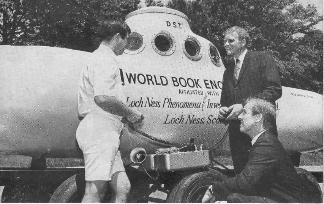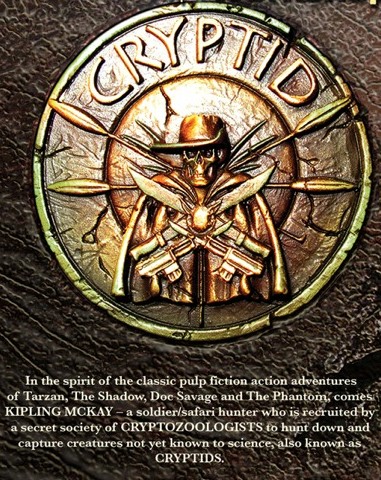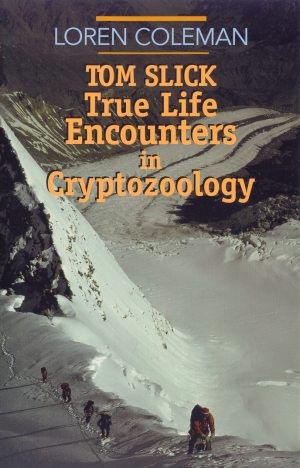
July 19, 2007

My late friend, colleague, and mentor, Ivan T. Sanderson, shown above with a lemur in his private zoo, was one of the first in America to try to organize those interested in cryptozoology into a formal “society.” What does his legacy look like today?
Matt Bille asked me a simple question: “How big is the cryptozoological community?”
Specifically, Matt wanted to know if anyone has tried to estimate the size of the cryptozoological community – that is, the number of people in North America particularly, who actively follow cryptozoological news and publications? How many people, Matt wondered, actually spend time following the subject?
Of course, no one knows, for certain, but I thought I would open the question here, by recording some historic highlights from my memory, and asking you what you think.
Several people, especially marketing people with magazines and publishers, often ask me and others these types of questions. Thus, I have, of course, tried to come up with some reasonable estimates. But estimates are all that exist. Still, that hasn’t stopped some of us from making guesstimates.
The steady climb from the very few people interested in Sea Serpents and Yeti in the 1950s, began with the “new age” of Sasquatch in the 1940s and early 1950s in Canada, then of Bigfoot in 1958 and 1967. The visible image of the Patterson-Gimlin footage had iconic symbolism for those that began to put a meaning to a new word from the late 1950s – “cryptozoology.”
In 1969, when Ivan T. Sanderson and I had an extended exchange about the number of those actively interested in cryptozoology, we figured the number was under 15 people doing serious research in the USA, which included those interested in Bigfoot in the eastern USA being about five people, and those in the PNW (northern California up to British Columbia) being only 30 souls. How many people followed what was happening? Very few.
Sanderson joked with me that he thought the dominant force studying the situation was the Russians. He might have been correct, followed by the French.

But things were slowly changing. During the early 1970s, I had about 400 mail (remember snail mail?) correspondents, which included Bigfoot, Nessie, cryptozoology, and Fortean enthusiasts. Sanderson’s Society of the Investigation of the Unexplained never had much more than 500 members. Sanderson died in 1973, and SITU limped along barely surviving after this death, for only a few years.
In the early 1980s, I recall talking to colleagues about this topic again, and noting maybe 500 to 700 people in North America were actively following cryptozoology and Bigfoot research (intensively to very casually), with maybe less than 100 active researchers out in the field, in the libraries, and writing. One could count on one hand the authors of note in the 1980s.
Created in 1982, and lasting a little over a decade, the International Society of Cryptozoology (ISC) never reached a membership that gave it financial security. As Jerome Clark noted in his 1993 book, Encyclopedia of Strange and Unexplained Physical Phenomena, the ISC’s magical money mark – 1000 members – always eluded it. When Clark wrote his entry in the early 1990s, the ISC membership was at about 850. This can be compared to Clark’s number for the International Fortean Organization of a little less than 800 members, also mentioned in his 1993 Encyclopedia.
Throughout the early 1990s, cable television began to build a screening room of documentaries, programming, and specials about cryptozoology, with the two favorites, Bigfoot and Nessie, creating many new fans. People would see the shows, and began searching out more to read about the cryptids. (As the number of cable channels in North America moved into the 300 range, frequent repeats of the 1990s’ cryptozoology programming would occur well into the next century.)
Then, beginning in 1995, the world wide web changed everything. Cryptozoologists, cryptozoologists-in-training, cryptowannabes, Bigfooters, random college students, Chupacabras fans, Nessie followers, Mystery Cat seekers, and people in general interested in these subjects found easy access via the Internet, and the cryptozoology community grew in leaps and bounds. Cryptozoology fans popped up all over the place. After reading materials online about these subjects and some creating their own websites, hundreds of people jumped into the field of cryptozoology with all hands and feet. Armchair followers found they could be actively involved, from researching old archives to gathering new reports. Websites could instantly broadcast news. Online diaries (early web logs, later blogs) and then videos of someone’s latest “fieldwork,” no matter the quality or outcomes, could go out to the whole world.

By the end of the 20th century, as I was discussing the numbers with associates, cryptozoologists, Bigfooters, editors, and publishers, the estimates were that between 4000-5000 people were actively involved in the field (with about 50 people doing all the writing, sharing, and exchanging of info on Bigfoot and cryptozoology data). Books with printings of 10,000 could easily sell out in a couple weeks, and nonfiction works could go into their 2nd printing in three weeks and be in their 8th printing in six months. Even cryptozoology fiction and comic books began selling in the bookstores and online, at an increasing pace.

Now, in 2007, you have 1,840,000 websites mentioning “cryptozoology,” 156,000 sites using the word “cryptid,” and 7,290,000 sites using the word “Bigfoot,” which covers more than just the cryptid Bigfoot, of course (some are about trucks and website domains). A more genuine reference point is that 2,750,000 sites mention “Sasquatch,” which today also covers popular cultural uses in comic books, golf clubs, and toys. The number of books on cryptozoology is amazing.
There are thousands of people interested in cryptozoology, today. For example, Cryptomundo is the number one cryptozoology site in the world, with Cryptomundo, for example, recording 2,000,000 page views in May 2007, from people around the globe. Most people reading the site are from North America, then followed by folks in other English-speaking countries, such as Australia, the UK, and with good numbers from Singapore, Japan, and elsewhere.
Since 1999, as a bit of personal reflection, I’ve written and had published new works or old ones revised to an ever-information-hungry readership that wants more and more about cryptids and the people searching for them. In
eight years, I’ve had a dozen of what I would call heavily cryptozoology-oriented books published, and numerous prefaces or introductions contributed to others’ published cryptozoology books (including some in cryptofiction novels).

What do you think? How many people around North America and spanning the Earth, do you think are in the “cryptozoology community”? Maybe there’s a marketing survey out there that has been done that I haven’t heard about?
About Loren Coleman
Loren Coleman is one of the world’s leading cryptozoologists, some say “the” leading living cryptozoologist. Certainly, he is acknowledged as the current living American researcher and writer who has most popularized cryptozoology in the late 20th and early 21st centuries.
Starting his fieldwork and investigations in 1960, after traveling and trekking extensively in pursuit of cryptozoological mysteries, Coleman began writing to share his experiences in 1969. An honorary member of Ivan T. Sanderson’s Society for the Investigation of the Unexplained in the 1970s, Coleman has been bestowed with similar honorary memberships of the North Idaho College Cryptozoology Club in 1983, and in subsequent years, that of the British Columbia Scientific Cryptozoology Club, CryptoSafari International, and other international organizations. He was also a Life Member and Benefactor of the International Society of Cryptozoology (now-defunct).
Loren Coleman’s daily blog, as a member of the Cryptomundo Team, served as an ongoing avenue of communication for the ever-growing body of cryptozoo news from 2005 through 2013. He returned as an infrequent contributor beginning Halloween week of 2015.
Coleman is the founder in 2003, and current director of the International Cryptozoology Museum in Portland, Maine.
Filed under Abominable Snowman, Bigfoot, Books, Breaking News, Comics, Cryptomundo Exclusive, Cryptotourism, CryptoZoo News, Cryptozoologists, Cryptozoology, Expedition Reports, Eyewitness Accounts, Lake Monsters, Living Dinosaurs, Loch Ness Monster, Media Appearances, Mothman, Movie Monsters, Mystery Cats, New Species, Ogopogo, Pop Culture, Public Forum, Sasquatch, Sea Serpents, Skunk Apes, Swamp Monsters, Television, Thunderbirds, Thylacine, Videos, Windigo, Year In Review, Yeti, Yowie